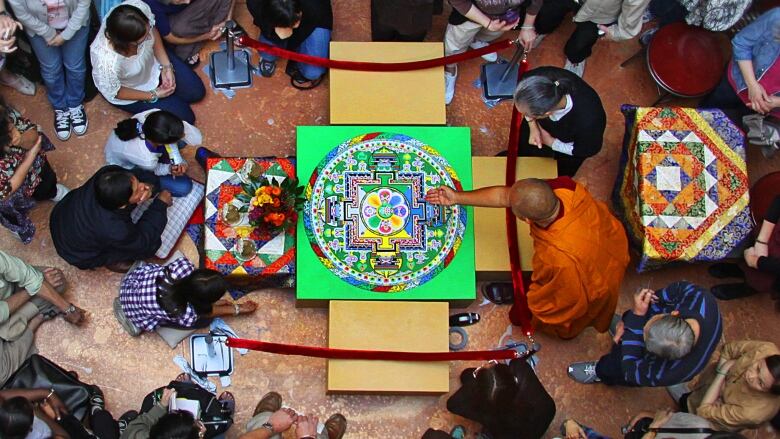Monks come to Calgary and create artwork that promotes peace and love
Sand mandala is a Tibetan art form that lives only for duration of its creation

Monks from south India came to Calgary last week for their global peace and compassion tourtaking place across Canada.
The monks spent their week at the Calgary Central Library spreading the "holy tradition" ofmandalas, an ancient and sacred form of Tibetan Buddhist art originating from 2,500 years ago.
"This kind of sand mandala of compassion is created and then brings and traps positive energy and promotes peace and helps generate love," said Thubten Lodoe, who was translating for Ven. Abbot Jampa Sopa.
Themonks travelled from the DzongkarChoede Monastery in India, which is home to 305 monks and knownas one of the oldest monasteries in the region.

Throughout the week, themonks spent eighthours a day bringing the mandalato life and laying millions of grains of coloured sand, which formedan intricate diagram of the enlightened mind and ideal world, according to a release.
"During the creation of the mandala, the monks who participate have to generate compassion. It has to be motivated by love and compassion and promote peace in the world," said Sopa through Choede.
"This will be our giving opportunity for people to receive blessings and the opportunity to see what kind of traditions they have."
History of the mandala
The mandala is circular and is meant to represent the universe and all that live in it.
"The creating of asand mandalafosters connection, respect, peaceand harmony between all living things," read the release.
"It is believed that these mandalas have the purification and healing power on these three levels and bring peace just by seeing them and letting one's mind merge with them."
The Tibetan art form lives only for the duration of its creation, but afterwards it is said it opens the door to the possibility of a future without violence.

In thefinal ceremonial gathering on Friday, the monks had the mandala destroyed and sanddistributed to the peoplefor the intent of helping them understand the true nature of impermanence.
"The dismantling ceremony represents the impermanence of the world. Any change can happen, so when that happens, our mind will not get disturbed that much because we are ready to face changes in the future," Sopa explained.
By viewing the mandala, he said, good nature will be increased and positive energy will attract.












_(720p).jpg)


 OFFICIAL HD MUSIC VIDEO.jpg)
.jpg)



























































































